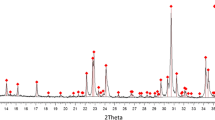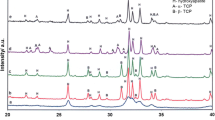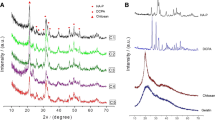Abstract
Calcium phosphate cements (CPCs) have recently gained great interest as injectable bone substitutes for use in dentistry and orthopedics. α-tricalcium phosphate (α-TCP) is a popularly used precursor powder for CPCs. When mixed with appropriate content of liquid and kept under aqueous conditions, α-TCP dissolves to form a calcium-deficient hydroxyapatite and then hardens to cement. In this study, α-TCP based cement (CP) and its composite cement with chitosan (Ch-CP) were prepared and the osteoclastic responses to the cements and their elution products were evaluated. Preliminary evaluation of the cements revealed that the CP and Ch-CP hardened within ~10 min at an appropriate powder-to-liquid ratio (PL) of 3.0. In addition, CP and Ch-CP were transformed into an apatite phase following immersion in a saline solution. Moreover, the osteoblastic cells were viable on the cements for up to 10 days. Mouse-derived bone marrow cells were isolated and activated with osteoclastic differentiation medium, and the effects of the CP and Ch-CP substrates and their ionic eluants on the osteoclastic activity were investigated. Osteoclastic cells were viable for up to 14 days on both types of cements, maintaining a higher cell growth level than the control culture dish. Multi-nucleated osteoclastic cells that were tartrate-resistant acid phosphatase (TRAP)-positive were clearly observed when cultured on the cement substrates as well as treated with the cement eluants. The TRAP activity was found to be significantly higher in cells influenced by the cement substrates and their eluants with respect to the control culture dish (Ch-CP > CP ≫ control). Overall, the osteoclastic differentiation was highly stimulated by the α-TCP based experimental cements in terms of both the substrate interaction and their elution products.









Similar content being viewed by others
References
Brown WE, Chow LC. A new calcium phosphate setting cement. J Dent Res. 1983;62:672.
Gruninger SE, Siew C, Chow LC, O’Young A, Ts’Ao NK, Brown WE. Evaluation of the biocompatibility of a new calcium phosphate setting cement. J Dent Res. 1986;63:200.
Bohner M. Reactivity of calcium phosphate cements. J Mater Chem. 2007;17:3980–6.
Wei X, Ugurlu O, Akinc M. Hydrolysis of a-tricalcium phosphate in simulated body fluid and dehydration behavior during the drying process. J Am Ceram Soc. 2007;90(8):2315–21.
Durucan C, Brown PW. α-tricalcium phosphate hydrolysis to hydroxyapatite at the near physiological temperature. J Mater Sci Mater Med. 2000;11:365–71.
Li Y, Zhang X, de Groot K. Hydrolysis and phase transition of alpha-tricalcium phosphate. Biomaterials. 1997;18(10):737–41.
Miyamoto Y, Ishikawa K, Takechi M, Toh T, Yuasa T, Nagayama M, Suzuki K. Basic properties of calcium phosphate cement containing atelocollagen in its liquid or powder phases. Biomaterials. 1998;19:707–15.
Miyazaki K, Horibe T, Antonucci JM, Takagi S, Chow LC. Polymeric calcium phosphate cements: analysis of reaction products and properties. Dent Mater. 1993;9:41–5.
Mickiewicz RA, Mayes AM, Knaack D. Polymer-calcium phosphate cement composites for bone substitutes. J Biomed Mater Res. 2002;61:581–92.
Cherng A, Takagi S, Chow LC. Effects of hxydroxypropyl methylcellulose and other gelling agents on the handling properties of calcium phosphate cement. J Biomed Mater Res. 1997;35:273–7.
Fujishiro Y, Takahashi K, Saito T. Preparation and compressive strength of a-tricalcium phosphate/gelatin gel composite cement. J Biomed Mater Res. 2001;54:525–30.
Khairoun I, Driessens FCM, Boltong MG, Planell JA, Wenz R. Addition of cohesion promotors to calcium phosphate cements. Biomaterials. 1999;20:393–8.
Xu HHK, Simon CG. Fast setting calcium phosphate–chitosan scaffold:mechanical properties and biocompatibility. Biomaterials. 2005;26:1337–48.
Xu HHK, Quinn JB, Takagi S, Chow LC. Synergistic reinforcement of in situ hardening calcium phosphate composite scaffold for bone tissue engineering. Biomaterials. 2004;25:1029–37.
Moreau Jennifer L, Xu Hockin HK. Mesenchymal stem cell proliferation and differentiation on an injectable calcium phosphate–chitosan composite scaffold. Biomaterials. 2009;30:2675–82.
Sashiwa H, Aiba S. Chemically modified chitin and chitosan as biomaterials. Prog Polym Sci. 2004;29:887–908.
Kumar R, Muzzarelli RA, Muzzarelli C, Sashiwa H, Domb AJ. Chitosan chemistry and pharmaceutical perspectives. Chem Rev. 2004;104:6017–84.
Xia Z, Grover LM, Huang Y, Adamopoulos IE, Gbureck U, Triffitt JT, Shelton RM, Barralet JE. In vitro biodegradation of three brushite calcium phosphate cements by a macrophage cell-line. Biomaterials. 2006;27:4557–65.
Schillingl AF, Linhart W, Filke S, Gebauer M, Schinke T, Rueger JM, Amling M. Resorbability of bone substitute biomaterials by human osteoclasts. Biomaterials. 2004;25:3963–72.
Monchau F, Lefevre A, Descamps M, Belquin-myrdycz A, Laffargue P, Hildebrand HF. In vitro studies of human and rat osteoclast activity on hydroxyapatite, beta-tricalcium phosphate, calcium carbonate. Biomol Eng. 2002;19(2–6):143–52.
Ferniindez E, Ginebra MP, Boltong MG, Driessens FCM, Ginebra J, De Maeyer EAP, Verbeeck RMH, Planell JA. Kinetic study of the setting reaction of a calcium phosphate bone cement. J Biomed Mater Res. 1996;32:367–74.
dos Santos LA, Carrodeguas RG, Boschi AO, de Arruda ACF. Dual-setting calcium phosphate cement modified with ammonium poly-acrylate. Artif Organs. 2003;27(5):412–8.
Author information
Authors and Affiliations
Corresponding author
Rights and permissions
About this article
Cite this article
Oh, SA., Lee, GS., Park, JH. et al. Osteoclastic cell behaviors affected by the α-tricalcium phosphate based bone cements. J Mater Sci: Mater Med 21, 3019–3027 (2010). https://doi.org/10.1007/s10856-010-4152-z
Received:
Accepted:
Published:
Issue Date:
DOI: https://doi.org/10.1007/s10856-010-4152-z




